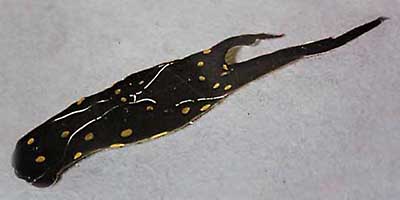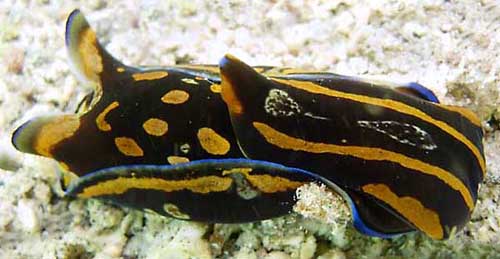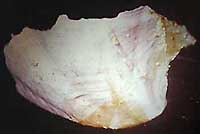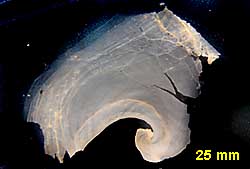Cephalaspidea |
||||
 |
 |
 |
 |
 |
| ORDER : CEPHALASPIDEA | ||
| Family : Aglajidae, Bullidae and Gastropteridae | ||
The name cephalaspidean means head-shield and alI members of this group have a well-developed head-shield which is used to plow beneath the surface of the sand.
The cephalaspideans are the most primitive opisthobranchs, they resemble to their prosobranch ancestors. The vast majority possess a shell, although it may be reduced and internal.
The least modified forms, like Acteon, have a shell with an elevated spire. Species such as Hydatina and Haminoea have an external shell with a bulloid spire. Philine and Chelidonura , have a reduced internaI shell. A shell is absent in some members of the Gastropteridae
In most cephalaspideans the mantle cavity faces the right side of the animal. In Chelidonura and Philine it is directed posteriorly . In Japonacteon it is directed anteriorly.
The vast majority of Cephalaspidea live just beneath the surface of the sand and are rather dull in their coloration
They all emit copious amounts of slime.
It was a largely carnivorous predatory group which dominates the marine sandy and muddy environments in which dwell a rich harvest of relatively immobile bivalves and polychaetes
The Aglajidae (Pilsbry, 1895)
Chelidonura (A.Adams, 1850)
Body and mantle : The anterior margin of the head shield is tri or quadri-lobed and acute. The caudal lobes are extremely elongate with the left lobe larger than the right.
Photo : C. punctata |
 |
|
Shell : Internal shell Shell thinly but completely calcified. Photo : C. punctata |
Behavior : Chelidonura are often brightly colored and are seen crawling on the surface of sand or rock. Chelidonura (as in Philinopsis) lacks a radula and ingest its prey whole by suction They prey on other large invertebrates and have well-developed sensory structures to detect prey. Chelidonura, in addition to having well developed eyes on the anterior end of the head has bundles of sensory cilia around its mouth. With these cilia it is able to track its prey by following its victim's mucus trail.
|
Philinopsis (Pease, 1860)
Body and mantle : The external body form consists of a rounded anterior margin, a rectangular head shield with a posterior, elongate flap. The parapodia are fleshy, short and do not significantly cover the dorsal shields. The posterior termination of the animal consists of blunt, quadrate caudal lobes which are generally very short or moderate.
Photo : C. cyanea |
 |
|
Shell : Internal shell The shell contains a narrow calcareous portion and a large, anteriorly directed, membranous or weakly calcified wing. Photo : C. cyanea |
Behavior : Philinopsis (as in Chelidonura) lacks a radula and ingest its prey whole by suction |

